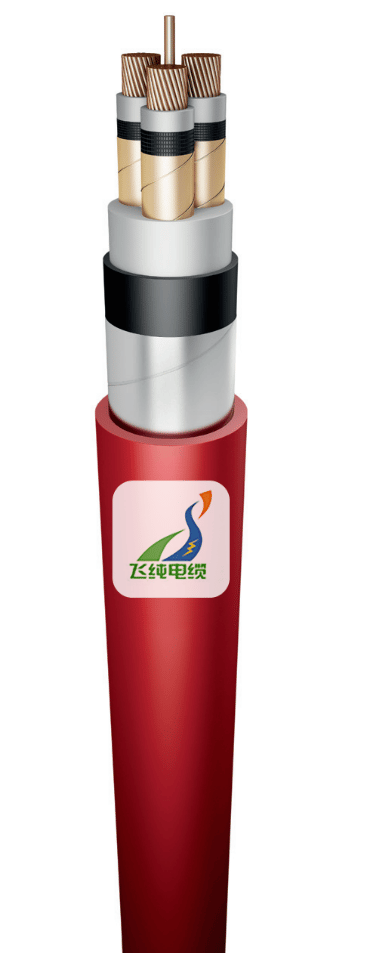Type YHKGXSFtlyn 3.6/6 kV Screened mining cables
Mining power cable with individual shield and copper core,
Insulated with cross-linked polyethylene, PVC coating, steel tape armor
Coated with flame retardant PVC outer shell


These mining power cables are designed for underground electrical installations in mining operations (with a rated voltage up to 6 kV).
They comply with the Polish standard ZN-TF-203:2014 and are suitable for use in areas with methane or coal dust explosion risks.
Construction & Materials
The cable is built with several layers to ensure durability, safety, and excellent electrical performance:
Conductor:
Made from compressed, multi-stranded, round copper wires (Class 2 per EN 60228).
Working Conductor Shield:
Each conductor is individually shielded using either a conductive tape or a conductive polyethylene-based material.
Insulation:
Uses cross-linked polyethylene (XLPE, type DIX 3) as insulation, following the PN-HD 620 S1:2002 standard.
Central Core:
The working conductors are twisted around a central copper wire or strand, which helps maintain cable stability.
Filler Layer:
A layer of unvulcanized rubber or tire-derived compound is applied to fill gaps.
Inner Sheath:
A PVC layer (type DMV 31, per PN-HD 620 S1:2002) is added for additional insulation and protection.
Armour:
A steel tape (galvanized iron, “Fe” tape) armor is wrapped around the cable to provide mechanical protection.
Outer Sheath:
The final layer is an outer flame-retardant PVC sheath (also type DMV 31), which is typically red in color.
Key Electrical & Mechanical Characteristics
Color Coding:
Insulation: Natural color
Outer Sheath: Red
Temperature Ratings:
Maximum operating temperature (conductor): 90 °C
Minimum ambient temperature (for permanently laid cables): –30 °C
Minimum temperature during installation (without preheating): –50 °C
Maximum temperature during a short-circuit: 250 °C
Bending Radius:
The cable should not be bent to a radius less than 12 times its overall diameter.
Test Voltage:
The cable is proof-tested at 15 kV AC for 5 minutes (50 Hz).
Flame Spread Resistance:
The cable meets the requirements of IEC 60332-1-2 and IEC 60332-3-24C.
Tensile Strength:
Maximum pulling force is calculated as 50 times the sum of the cross-sectional areas (in mm²) of the working conductors.
Packaging Options:
Standard reels come in lengths of 500 or 1,000 meters, though other options may be available.
Electrical Specifications & Derating Factors
Available Sizes:
The cables come in various conductor sizes (e.g., 3×25, 3×35, 3×50, up to 3×240 mm²). Detailed tables specify the insulation and sheath thicknesses, overall cable diameter, weight per kilometer, and maximum conductor resistance at 20 °C.
Current Carrying Capacity:
A table provides the rated current (in amperes) for different conductor cross-sections along with unit inductance (mH/km) and unit inductive reactance (Ω/km).
Derating Factors:
Parallel Installation: When cables are installed one above the other on supports, the current capacity must be reduced using correction factors:
1 cable: 1.00
2 cables: 0.93
3 cables: 0.90
6 cables: 0.87
9 cables: 0.86
Ambient Temperature: For ambient temperatures above 25 °C, further correction factors are applied (e.g., at 30 °C: 0.96; 35 °C: 0.92; 40 °C: 0.88; up to 55 °C: 0.73).
Application
These cables are intended for use in underground power networks in mining plants where the supply voltage does not exceed 6 kV. They are approved for use in both methane and non-methane zones, including areas with different classifications of explosion hazards (methane explosion classes A and B, and coal dust explosion risks).
Certifications
The cable holds certifications and approvals from relevant bodies such as EMAG and WUG.

Frequently Asked Questions (FAQ)
Q: What is the rated voltage of these mining cables?
A: The cables are designed for use in networks with a rated voltage of 3.6/6 kV.
Q: What are the primary applications of this cable?
A: They are intended for underground power distribution in mining plants, suitable for both methane and non-methane areas, including hazardous zones with explosion risks.
Q: What type of conductor is used in these cables?
A: The conductor is made from compressed, multi-stranded round copper wires (Class 2 as per EN 60228).
Q: How are the individual conductors protected electrically?
A: Each conductor is individually shielded using a conductive tape or a conductive polyethylene-based material to ensure proper performance.
Q: What insulation material is used in these cables?
A: The insulation is made of cross-linked polyethylene (XLPE), specifically type DIX 3 in accordance with PN-HD 620 S1:2002.
Q: What additional mechanical protection does the cable have?
A: The cable includes a steel tape armor layer that provides robust mechanical protection, making it ideal for harsh mining environments.
Q: Is the outer sheath flame retardant?
A: Yes, the outer sheath is made of flame-retardant PVC (type DMV 31) that complies with IEC standards for flame spread resistance.
Q: What are the maximum temperature ratings for the cable during normal operation?
A: The working conductor can operate at a maximum temperature of 90 °C.
Q: How does the cable perform during short-circuit conditions?
A: During a short-circuit, the conductor can reach temperatures up to 250 °C, as specified.
Q: What are the minimum ambient temperature requirements for permanent installations?
A: The cable is designed to operate in ambient temperatures as low as –30 °C for permanently laid installations.
Q: Can these cables be installed in extremely cold conditions without preheating?
A: Yes, they can be installed at temperatures as low as –50 °C, even without preheating.
Q: What is the minimum bending radius for installation?
A: The minimum bending radius is 12 times the overall cable diameter, ensuring the cable is not damaged during installation.
Q: How is the cable tested for electrical integrity?
A: The cable undergoes a proof test at 15 kV AC for 5 minutes (50 Hz) to verify its insulation quality and overall integrity.
Q: What certifications does this cable have?
A: The cable is certified by bodies such as EMAG and WUG, ensuring compliance with industry standards.
Q: How is the cable packaged for delivery?
A: Standard packaging is available in 500 or 1,000-meter reels, though customized lengths and packaging types can be arranged.
Q: What measures are in place to handle the risk of explosion in mining areas?
A: The cable is specifically designed and approved for use in zones with potential methane or coal dust explosion risks (classes A and B).
Q: How does the layered construction enhance the cable’s durability?
A: Its construction includes copper conductors, individual shielding, XLPE insulation, a robust PVC inner layer, steel tape armor, and a flame-retardant PVC outer sheath—each layer adds protection against electrical, thermal, and mechanical stresses.
Q: What are the correction factors for current capacity when cables are installed parallel on supports?
A: If cables are laid one above the other, the rated current must be derated using specific factors, for example, 0.93 for 2 cables, 0.90 for 3 cables, 0.87 for 6 cables, and 0.86 for 9 cables.
Q: Are there additional derating factors for ambient temperatures above 25 °C?
A: Yes, for ambient temperatures exceeding 25 °C, additional correction factors are applied (e.g., 0.96 at 30 °C, 0.92 at 35 °C, 0.88 at 40 °C, down to 0.73 at 55 °C).
Q: How do the electrical properties (such as resistance and inductance) affect performance?
A: Detailed electrical characteristics, including maximum conductor resistance, unit inductance, and inductive reactance, ensure efficient power delivery and minimal losses, which are critical for mining applications.
Q: What benefits do copper conductors provide in this cable?
A: Copper offers excellent electrical conductivity and durability, ensuring high performance and longevity in demanding mining environments.
Q: Can this cable be used for both new installations and retrofits in mining operations?
A: Absolutely. The cable’s robust design and adherence to strict standards make it suitable for both new installations and retrofit projects in the mining industry.
Q: How does the individual shielding of each conductor improve cable performance?
A: Individual shielding minimizes electromagnetic interference (EMI) and ensures balanced voltage distribution, which is especially important in complex underground mining networks.
Q: Why is the use of steel tape armor important for mining cables?
A: The steel tape armor provides excellent mechanical protection against impacts, abrasion, and rodent damage, making the cable resilient in harsh mining conditions.
Q: What long-term reliability features make this cable ideal for mining environments?
A: The multi-layer construction, robust materials, compliance with high temperature and flame retardancy standards, and proven electrical performance ensure that the cable will reliably withstand the challenges of mining applications over time.






Type YHKGXSFtlyn 3.6/6 kV Screened mining cables
Type YHKGXSFtlyn 3.6/6 kV Screened Mining Cable – a robust, high-performance cable designed for underground mining. Built to Polish standard ZN-TF-203:2014, it features multi-stranded, individually shielded copper conductors, XLPE insulation, a PVC inner sheath, steel tape armor, and a flame-retardant PVC outer jacket. This cable is engineered for extreme conditions, ensuring reliable, long-term power delivery in hazardous mining environments.
6/30/20216 min read
